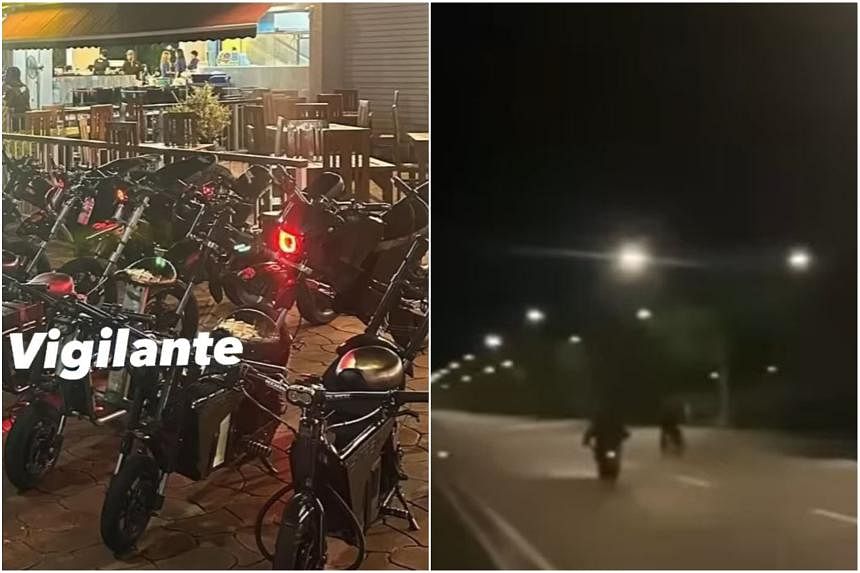SINGAPORE - The Land Transport Authority (LTA) is investigating several incidents involving several power-assisted bicycles (PABs) and e-scooters.
In a video shared on Facebook page SG Road Vigilante, several PABs and e-scooters can be seen racing at high speeds in several locations, including Tanah Merah Coast Road and a park connector running alongside the Bay East Garden next to Marina Bay.
One clip shows a rider appearing to adopt a Superman position – lying face down on the device with his legs straightened and pointed backwards.
The video’s caption claims that the e-bikes – which PABs are commonly known as – and e-scooters have been illegally modified and are travelling at speeds in excess of 140kmh.
Responding to queries from The Straits Times, LTA said it has also stepped up enforcement efforts in these locations and will take individuals to task if they are found to be violating regulations.
While e-bikes are allowed to travel on cycling paths and on the road, e-scooters can be used only on the former. Neither of these devices can be used on a footpath.
A speed limit of 25kmh is also imposed on cycling paths.
Both e-bikes and e-scooters have to be registered with LTA and be operated by a person at least 16 years of age, if unsupervised.
E-scooters are designated as personal mobility devices, which also include skateboards, kick scooters, motorised skateboards and hoverboards.
Riders must also pass online theory tests before being allowed to use e-bikes or e-scooters.
E-bikes are also required to meet technical specifications such as a weight limit of 20kg, a maximum continuous power output of 250 watts, a maximum assisted speed of 25kmh and certification to the EN15194 standard.
E-scooters have to be certified to the UL2272 fire safety standard.
A check by ST on second-hand sales platform Carousell and messaging app Telegram showed multiple listings of e-bikes being advertised for sale with features such as throttles and motors rated at 1,000 watts. Similar motors – ranging in power from 1,500 watts to 3,000 watts – were advertised separately on the platforms.
Sellers of e-bikes whom ST spoke to said these features are in clear violation of LTA’s regulations.
An employee of e-bike vendor Warehouse SG, who identified himself only as Mr Chia, told ST that the motors used to propel e-bikes should be activated only when the rider starts pedalling, and should cut off when the e-bike reaches 25kmh.
He said: “The motors on the e-bikes that we sell have a maximum power of 250 watts. While it is possible for someone riding an e-bike to travel faster than 25kmh (on these bikes), they should not be doing so with the help of the motor.
“Throttles mounted on the handlebar similar to those on motorbikes are also not permitted to be installed on e-bikes as such.”
Mr Chia said that while Warehouse SG does provide repair and upgrading services for e-bikes, it would do so only if the modifications fall within LTA’s guidelines.
He said: “Sometimes a rider wants to install a bigger battery so that they can keep riding longer distances, as is the case for food delivery riders, but these batteries also need to be approved by LTA.
“The customers who ask for motors exceeding LTA’s regulations might want to travel faster so they can complete more deliveries or because they feel that it is easier to manoeuvre through traffic on the road.”
Identifying herself only as Ms Lee, a sales representative from e-bike brand Jimove said she would often advise customers against purchasing illegally modified e-bikes, or modifying e-bikes purchased from her company.
“The riders who modify their e-bikes to go faster tend to be the ones who work at night, when the roads or paths are not as busy. Their vehicles can travel at 40kmh to 50kmh, which can be very dangerous for the riders and pedestrians,” she said.
Under the Active Mobility Act, a person found guilty of illegally modifying an e-bike such that it does not comply with LTA’s regulations can be jailed up to two years, fined up to $20,000 or both for the first offence. Subsequent offences may be punishable by a jail term of up to four years, a fine of up to $40,000 or both.
Riding a non-compliant e-bike on public paths may land a person in jail for up to six months, a fine of up to $10,000, or both for the first offence, with subsequent offences punishable with up to 12 months’ imprisonment, a fine of up to $20,000 or both.
A person found guilty of dangerous or reckless riding on public paths may be jailed for up to 12 months, fined up to $10,000 or both.


